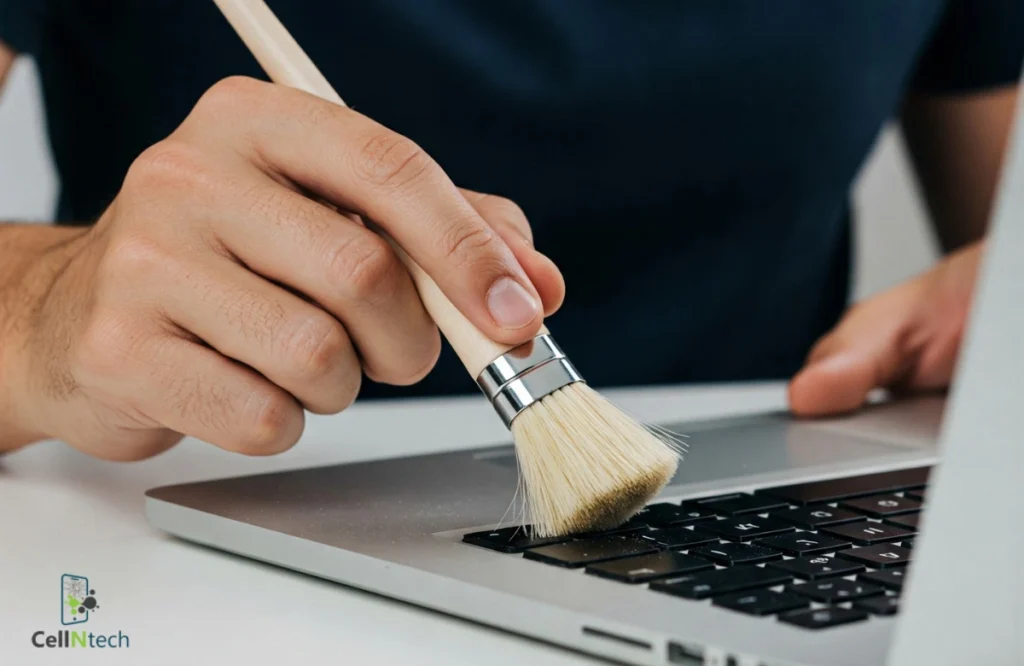macbook
How To Clean MacBook Keyboard Without Compressed Air
Over time, dust can gather on your MacBook keyboard, reducing its performance and efficiency. The keys become unresponsive and sticky if they are not cleaned properly. Compressed air is an effective solution for keyboard cleaning, but it is not always available at home. So, it is better to look for other options. But how can you clean a MacBook keyboard without compressed air? The best strategy is to use a microfiber cloth. It easily gets rid of the surface dust. For stuck debris, you should use a soft brush. Isopropyl alcohol is effective for thoroughly and safely cleaning the keys. If these solutions don’t work, consider seeking MacBook repair services to address any underlying issues. You can also start using a keyboard cover to maintain cleanliness in the future.
7 Ways To Clean MacBook Keyboard Without Compressed Air
Regular cleaning is important to keep your MacBook keyboard in good condition. With use, crumbs, dust, and oil can stick to the keys, reducing the overall keyboard performance and typing experience. Here are the most effective solutions to try for cleaning your keyboard without compressed air:
1. Take a Microfiber Cloth
Use a microfiber cloth to remove light dirt, fingerprints, and dust from your keyboard. Gently wipe the surface in a circular pattern. For stubborn dirt and stains, wet the cloth a little, but don’t soak it. Water may seep through the keys and leak inside your keyboard. Paper towels leave fibers and lint behind, while microfiber cloths are excellent for cleaning because they leave no residue.
2. Use Isopropyl Alcohol
Isopropyl alcohol (70%) is safe and effective for keyboard cleaning. It has quick evaporation properties and leaves no residue behind. Take a cotton swab, dip it in alcohol, and clean each key separately. Isopropyl alcohol cleans the keyboard by breaking down oil particles and serves as a disinfectant.
3. Take a Soft-Bristled Brush
Nothing works better than a soft-bristled brush to remove dust and crumbs between the keys. A cloth cannot reach the crevices and corners, leaving the dirt stuck in certain keyboard parts. The soft bristles can access these areas and remove the particulate matter. You can also use a paintbrush for this purpose. But don’t use a hard brush, as it can scratch your keyboard’s surface.
4. Use a Keyboard Cleaning Gel
There is a variety of keyboard-cleaning gels available in the market. Commercially prepared gels can reach between the keys and have sticky formulations to collect dirt and crumbs effectively. It is a safe and easy solution for daily keyboard cleaning. Follow the manufacturer’s guidelines while using these gels for effective results.
5. Apply Vacuum
A low-powered small handheld vacuum is also safe for debris removal from your Mac keyboard. Attach the brush nozzle for better results. Gentle suction will lift off the dust without damaging the keys. Position the vacuum nozzle slightly above the keyboard’s surface level to prevent pulling the keys out of their position. It is ideal for removing large crumbs from between the keys that are difficult to remove using a cloth or brush.
6. Remove and Clean Keycaps
An ideal strategy for cleaning the MacBook keyboard with removable keys is to use a puller tool. Use the softest brush and isopropyl alcohol solution to clean each key separately. After completely cleaning, replace the keys exactly as they were originally positioned. It is a long process but guarantees a deep clean of heavily used keyboards.
7. Use Sticky Notes or Adhesive Tape
Sticky notes or adhesive tape can also help clean between the keys. Touch the sticky side of the tape or paper to the desired area, and it will collect the crumbs and dust. This is an effective and economical strategy for light cleaning. Do not leave the tape or sticky notes on the keyboard for too long to prevent residue buildup.
Benefits of Cleaning MacBook Keyboard Without Compressed Air
Some advantages of cleaning a MacBook keyboard without compressed air are:
- Prevents Liquid Propellant Residue: It prevents liquid propellant residue from accumulating on your keyboard due to excessive moisture.
- Cost-Effective: Cleaning a Mac keyboard with isopropyl alcohol and a microfiber cloth is cheaper than using a compressed air can.
- Eco-Friendly: Disposable air cans harm the environment, while microfiber cloths are relatively safer.
- Prevents Damage: Compressed air can pull off the keys if you don’t maintain a suitable distance between the keyboard and the can.
Conclusion
Regular cleaning of your MacBook keyboard ensures smooth performance and prevents dust build-up. Compressed air is an effective solution for keyboard cleaning but is not readily available at every home. To clean your MacBook keyboard without compressed air, use a microfiber cloth for safe cleaning, and apply isopropyl alcohol for effective cleaning and disinfection. A soft-bristled brush best removes crumbs and tough dirt from the crevices. You can also use a small handheld vacuum cleaner to clean between the keys. Clean your hands before typing on your MacBook, and use a keyboard cover to maintain hygiene levels. If these solutions don’t work well, bring it to Cell N Tech for professional cleaning. We use the safest methods to clean your keyboard and improve its performance without damaging it.




